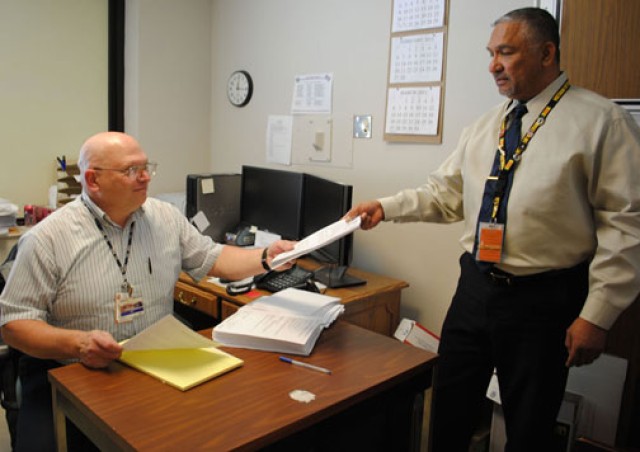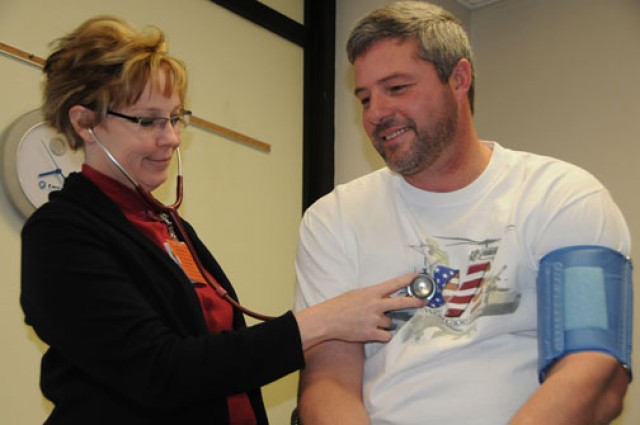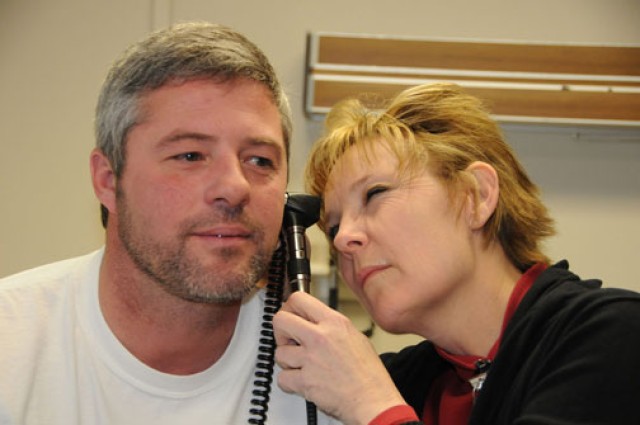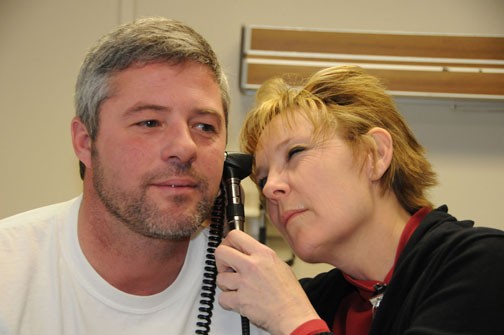A joint initiative between the Department of Defense and Department of Veterans Affairs aims to simplify and streamline the delivery of disability services and benefits for wounded, injured or ill servicemembers who are unable to continue service.
The new Integrated Disability Evaluation System, or IDES, makes the overall evaluation process faster and simpler for servicemembers, according to Col. Sheila Hobbs, the chief of patient administration for the Office of the Surgeon General, who helped develop the new system. IDES provides servicemembers a seamless transition from active duty to veteran status, she added.
On average, Soldiers evaluated through IDES received their VA disability benefits more than 50 percent faster than those evaluated through the legacy system in use by the Army since 1949, according to Col. Daniel Cassidy, deputy commander of the U.S. Army Physical Disability Agency, headquartered at Walter Reed Army Medical Center in Washington.
Under the older system, Soldiers had to separate from service with discharge papers in hand before entering the VA system, sometimes waiting more than a year before receiving VA benefits. Soldiers enrolled in the new system can begin their VA disability claim within 10 days of initiating the process with the Army, according to Denise Brown, the lead physical evaluation system board consultant with the Office of the Surgeon General, who has been involved with IDES since the system launched in 2007. The system is designed so that servicemembers can receive their first VA check 30 days after they separate from service.
Both DOD and the VA align resources in this new process that uses a single, comprehensive, head-to-toe physical examination and single-source disability rating, which eliminates redundant medical exams and disability ratings. Before IDES, Soldiers received two ratings: one from the Army based on Army medical exams and a separate rating from the VA based on VA exams. Additionally, each military service had a different rating system, which led some servicemembers to question whether the ratings they received were fair.
"It was difficult for Soldiers to understand (that the VA and Army) were looking at different things," said Cassidy, who said the legacy system appeared adversarial to some, pitting Soldier against service.
Now each military service uses the same DOD rating system and the same comprehensive physical exam by a VA-certified doctor. VA evaluators rate servicemembers' disabilities, and servicemembers receive a "service unfitting" rating and a single VA-determined disability rating that both DOD and the VA recognize. Single, comprehensive exams and single-source disability ratings have enhanced the delivery of compensation and benefits, while also reducing the uncertainty associated with navigating through separate DOD and VA systems.
Soldiers who are unable to return to full military duty because of an illness or injury are referred to a medical evaluation board and assigned a physical evaluation board liaison officer, to help steer them through the entire Army process until they separate. Each Soldier is also assigned a VA military service coordinator to help them navigate the VA system.
One Soldier, currently awaiting her fit-for-duty decision through IDES, said her PEBLO contacted her right away and she started her VA appointments from the very beginning.
"I've got an awesome PEBLO," said the combat medic who was injured while serving in Iraq. "She's pretty good (about) contacting me. She gives me e-mail updates every week." The medic called Audrey George, a PEBLO at Walter Reed Army Medical Center, the "middle man" who keeps both her and the command well informed. Although it may be several more weeks before she receives her rating, the Soldier said the wait is worth it, and the entire process was smooth.
"I already expected to go through this," she explained. "There's no guessing. Everything gets done before I'm out-that's the good part."
Denise Brown, a physical disability evaluation system consultant with the Office of the Surgeon General who helped develop IDES, said keeping Soldiers informed and eliminating the guesswork highlights the transparency of the new system.
Brown added that enhanced case management is also a key feature of IDES. Case managers help identify additional resources to assist servicemembers and their Families. Through IDES, trained PEBLOs, military service coordinators for the VA, medical evaluation board providers and other professionals work together to assist Soldiers going through the disability process.
"They just feel that there's a lot more support. They have a lawyer (medical evaluation board outreach counselor), ombudsman, PEBLO (and) MSC (military service coordinator) on their side," explained Mark Rivera, a supervisory PEBLO at Irwin Army Community Hospital in Fort Riley, Kan. "It's our job that they know we're here to help them."
Teamwork and collaboration are a part of enhanced case management. Lynda Hurley, the VA officer in charge for the Veteran Outreach Program in the National Capital Region, helped develop the IDES pilot at Walter Reed Army Medical Center. Hurley oversees staff at Walter Reed; Fort Belvoir, Va.; Joint Base Andrews Naval Air Facility, Md.; Marine Corps Base Quantico, Va, and National Naval Medical Center in Bethesda, Md. She feels like a part of the team with IDES, and said the new system has brought additional improvements to the disability process.
With IDES, Soldiers at the beginning of the process, like Cpl. Matthew Kinsey of Walter Reed Warrior Transition Brigade's Battle Company, are assigned a military service coordinator who guides them through the VA portion of the process.
Kinsey, a paratrooper injured June 2, 2010, in Afghanistan, met face-to-face with his MSC, Robert Bozgoz, to initiate his VA claim. This "face of the VA" is located in the same barracks where Kinsey lives. Hurley called the location more user-friendly.
Regular communication between VA military service coordinators, Army PEBLOs and the Soldiers they assist is a key feature of IDES. At Fort Riley, MSCs and PEBLOs are co-located. They form a one-stop shop to improve efficiencies for continuity of care, and stay connected with the Soldier throughout the process.
Jackie Floyd said collocation is an ideal situation. The former Soldier, with more than 10 years of experience in physical disability evaluation, currently serves as a PDES consultant and provides support to PEBLOs for the Northern Regional Medical Command.
"It's a benefit for everyone," said Floyd, who explained that collocation helps build relationships and increases Soldier satisfaction.
"IDES has increased their trust in their PEBLO and the Army. Things work out at the end-(Soldiers) know they have someone there looking out for the best outcome," Floyd said, adding that developing a system of trust is critical.
Sergeant Antoine King is a flight medic with Company C 1-169 Medical Company (Air Ambulance), Maryland National Guard, in Edgewood, Md. When he first arrived at WRAMC in February 2009, other Soldiers told him the disability evaluation process could take up to a year or two. However, King, who is nearing the end of the process at Walter Reed, said his transition to medical retirement has been smooth and well organized so far.
After he completed his comprehensive assessment at the VA, King knew in advance who he would talk to next and what they were going to do. All that information up front was a plus, he said, adding that he was relieved when he learned he would be processed under IDES.
Floyd said an additional 40 days are added to the process for Guard and Reserve Soldiers, who are often treated by civilian providers, to collect all medical records pertaining to their case. "You're dealing with Soldiers with a civilian life...civilian jobs...not full-time Soldiers," Floyd said.
Leaders said the goal is to have a transparent and efficient IDES that has the trust of both Soldiers and their Families.
"I do think this is a good thing for the Soldier and the Army," said Cassidy, who called IDES a vast improvement from the legacy system. He explained, however, that more progress could be made. Until changes to DOD policies allow the services to accept VA ratings, the services can only evaluate on unfit conditions. Cassidy believes changes to these policies will whittle the 295-day average wait time for Soldiers to a mere 75 days.
Twenty-two Army military treatment facilities are using IDES. The new system, currently in phase three, will expand to five more locations before the fourth and final phase begins in July. Phase four will bring IDES to nine more MTFs, both stateside and overseas.
According to Cassidy, the Air Force, Navy and Marines have also initiated IDES and will continue to implement the system in stages. "The services will continue to collaborate and improve the IDES to make it better for all servicemembers," Brown said. "We're all working together."
Sharon Renee Taylor works for Walter Reed Army Medical Center Public Affairs.








Social Sharing